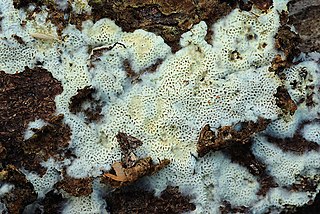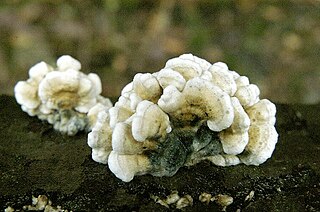
The Tricholomataceae are a large family of fungi within the order Agaricales. Originally a classic "wastebasket taxon", the family included any white-, yellow-, or pink-spored genera in the Agaricales not already classified as belonging to e.g. the Amanitaceae, Lepiotaceae, Hygrophoraceae, Pluteaceae, or Entolomataceae.

The Agaricomycetes are a class of fungi in the division Basidiomycota. The taxon is roughly identical to that defined for the Homobasidiomycetes by Hibbett & Thorn, with the inclusion of Auriculariales and Sebacinales. It includes not only mushroom-forming fungi, but also most species placed in the deprecated taxa Gasteromycetes and Homobasidiomycetes. Within the subdivision Agaricomycotina, which already excludes the smut and rust fungi, the Agaricomycetes can be further defined by the exclusion of the classes Tremellomycetes and Dacrymycetes, which are generally considered to be jelly fungi. However, a few former "jelly fungi", such as Auricularia, are classified in the Agaricomycetes. According to a 2008 estimate, Agaricomycetes include 17 orders, 100 families, 1147 genera, and about 21000 species. Modern molecular phylogenetic analyses have been since used to help define several new orders in the Agaricomycetes: Amylocorticiales, Jaapiales, Stereopsidales, and Lepidostromatales.

Atheliaceae is a family of corticioid fungi placed under the monotypic order Atheliales. Both the order and the family were described by Walter Jülich in 1981. According to a 2008 estimate, the family contains 20 genera and approximately 100 species. However, many genera formerly considered to belong in the Atheliaceae have since been moved to other families, including Amylocorticiaceae, Albatrellaceae, and Hygrophoraceae. Despite being a relatively small group with inconspicuous forms, Atheliaceae members show great diversity in life strategies and are widespread in distribution. Additionally, being a group strictly composed of corticioid fungi, they may also provide insights on the evolution of fruiting body forms in basidiomycetes.

Anomoporia is a genus of fungi in the family Amylocorticiaceae. The genus was circumscribed by Czech mycologist Zdeněk Pouzar in 1966.

Ceraceomyces is a genus of fungi in the family Amylocorticiaceae. The genus has a widespread distribution and contains 16 species.

Anomoloma is a genus of crust fungi in the family Amylocorticiaceae. It was circumscribed by mycologists Tuomo Niemelä and Karl-Henrik Larsson in 2007. The generic name is derived from the Greek anomos, meaning "lawless", which in this context alludes to the irregular rhizomorphic outline, and loma, meaning margin or edge.
Jaapia is a genus in the monotypic family Jaapiaceae and order Jaapiales. The genus was first described by Italian mycologist Giacomo Bresadola in 1911, and contains two widely distributed species, J. argillacea and J. ochroleuca. The order was described in 2010.

The corticioid fungi are a group of fungi in the Basidiomycota typically having effused, smooth basidiocarps that are formed on the undersides of dead tree trunks or branches. They are sometimes colloquially called crust fungi or patch fungi. Originally such fungi were referred to the genus Corticium and subsequently to the family Corticiaceae, but it is now known that all corticioid species are not necessarily closely related. The fact that they look similar is an example of convergent evolution. Since they are often studied as a group, it is convenient to retain the informal (non-taxonomic) name of "corticioid fungi" and this term is frequently used in research papers and other texts.
Serpulomyces is a genus of fungi in the family Amylocorticiaceae. The genus is monotypic, containing the single species Serpulomyces borealis, found in Europe. Serpulomyces was described by Ivan Zmitrovich in 2002.
Irpicodon is a genus of fungi in the family Amylocorticiaceae. The genus is monotypic, containing the single species Irpicodon pendulus, found in Europe.

Amyloxenasma is a genus of corticioid fungi in the family Amylocorticiaceae. The widely distributed genus contains six species.

Amylocorticium is a genus of resupinate (crust-like) fungi in the Amylocorticiaceae family. The genus has a widespread distribution and contains 11 species.
Amylocorticiellum is a genus of fungi in the family Amylocorticiaceae. The genus has a widespread distribution and contains four species.
Amyloathelia is a genus of fungi in the family Amylocorticiaceae. The genus contains three species distributed in Europe and South America.
Aphanobasidium is a genus of corticioid or crust fungi in the Radulomycetaceae family. The genus has a widespread distribution and contains several species. This genus was formally considered to be part of the Pterulaceae family.

Amylocorticiales is an order of fungi in the class Agaricomycetes. The order was circumscribed in 2010 to contain mostly resupinate (crust-like) forms that have been referred to genera Anomoporia, Amyloathelia, Amylocorticiellum, Amylocorticium, Amyloxenasma, Anomoloma, Athelopsis, Ceraceomyces, Hypochniciellum, Leptosporomyces and Serpulomyces and the anomalous species, Athelia rolfsii, now classified in its own genus, Agroathelia.

Plicaturopsis is a genus of fungi in the family Amylocorticiaceae. The genus was circumscribed by English mycologist Derek Reid in 1964. In 2023 P. scarlatina was reclassified to Phlebia making P. crispa the only described species in the genus.
Hypochniciellum is a genus of corticioid fungi in the family Amylocorticiaceae. Species in the genus have white to cream, resupinate fruit bodies. The hyphae have clamp connections. The spores are roughly elliptical, yellowish, and smooth.

Leptosporomyces is a genus of resupinate (crust-like) fungi in the family Amylocorticiaceae. The genus is widespread in the Northern Hemisphere and contains 11 species.

Agroathelia is a fungal genus currently consisting of one widespread and two other species. Agroathelia rolfsii, the type species, causes serious diseases of cultivated crops such as tomatoes, potatoes, peanuts, bell peppers, and sweet potatoes among many other hosts. It is better known under the names Sclerotium rolfsii or Athelia rolfsii.










